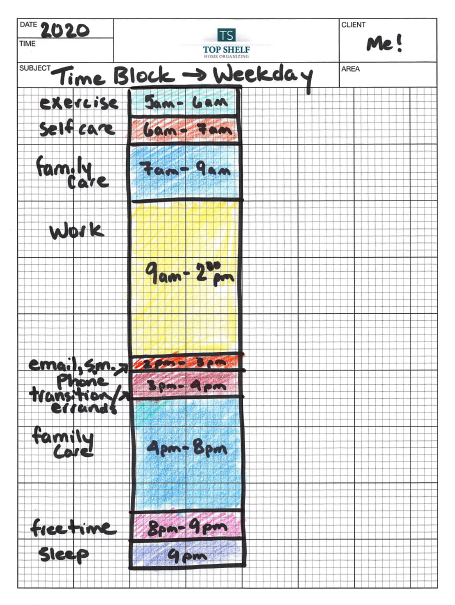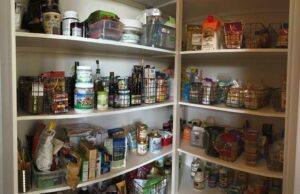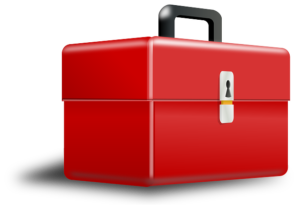by Jayme Radomski | Mar 10, 2020 | Bathroom, Clutter, Organizing
 Let’s be ruthless and get our overstuffed linen closets cleared out for real. We expect these little closets to hold too many items. To get the linen closet to a reasonable condition, lets look at the contents category by category. Empty out all the contents of this closet. Also, consider linen closet items that are not stored in the linen closet but fall into these categories. You might find these items in your bathroom, under your bed, in the kitchen, in the bedroom closet, and possibly in the car, garage, basement or attic. After we retrieve these items from around the house, sort them by category. Once we follow the guidelines below for each category, we can have fun organizing them back into the closet and labeling for continued organization.
Let’s be ruthless and get our overstuffed linen closets cleared out for real. We expect these little closets to hold too many items. To get the linen closet to a reasonable condition, lets look at the contents category by category. Empty out all the contents of this closet. Also, consider linen closet items that are not stored in the linen closet but fall into these categories. You might find these items in your bathroom, under your bed, in the kitchen, in the bedroom closet, and possibly in the car, garage, basement or attic. After we retrieve these items from around the house, sort them by category. Once we follow the guidelines below for each category, we can have fun organizing them back into the closet and labeling for continued organization.
At Top Shelf, we feel less is more and we like to keep only what we need. Here is a guideline of some typical items to consider.
- Paper Products
The linen closet is an ideal space to store extra paper products such as toilet paper and facial tissue. Keep a minimal amount of back up product in your bathroom due to limited space and the humid environment. Purchasing paper products in bulk can save money, but be aware of your storage space. You will want to avoid too much overflow into other areas of your home, unless you have ample overflow storage.
- Bath Towels
Keep two towels per person living in your house, and a couple fresh towels for guests. The extra towels can be donated to a local pet shelter.
- Hand Towels
Keep two or three hand towels per bathroom, or two hand towels per person living in your home. A couple fresh hand towels for guests is acceptable. Extra towels can be donated to a local pet shelter.
- Wash Clothes
Inventory your wash clothes and keep exactly what your family uses per week. Some people may use two wash clothes per day and others may only use a wash cloth on occasion. This category is very specific to your household. Consider donating extras to an animal shelter.
- Beach Towels
Beach towels are also unique to your household. The amount you need will depend on your lifestyle, how often you are at the beach, at the pool, on a boat or camping. You will need to figure out how many beach towels are reasonable to keep. If your kids spend their summer at camp with a swimming pool, you may want to consider a few extra towels in your inventory. If your family is more of a weekend warrior at the beach and lake, one towel per person is reasonable. These seasonal towels can be packed away and placed into storage during the winter, if they are not needed. Remember, you can always toss them in the wash when you get back from the lake or the pool so they are ready for the next day. Extra beach towels can also be donated to a local animal shelter.
- Medical Equipment
Medical equipment can take up a large section of real estate in a linen closet. Equipment only used seasonally or during an occasional illness may be stored in another location such as the basement or a larger closet. Equipment that is used regularly can remain in the linen closet as long as there is space.
- Medications
Medication’s should be gone through on a regular basis. When going through medications, gather all your medications in one location. Check the expiration dates of all medications. Also, consider medications that are not needed anymore. After the unneeded and expired are removed, you can sort the remaining into categories such as daily use, illness specific and kids’ medications. Local pharmacies and governments host collection days to safely dispose of medications.
- Toiletries and Personal Care Items
Toiletries and personal care items should be gathered and sorted. Remove the items that are expired, old and not used anymore. Place partially used products in the front of the closet to use them up first. Plan to use up your inventory of products before purchasing new items. Write down your inventory or take a photo to help resist the temptation to purchase these products before depleting what you have. These products tend to build-up, especially if you are into trying the newest products. Unopened, unexpired and unwanted products can be donated to local homeless shelters.
- Cosmetics
Before we dive into cosmetics, lets have a quick general discussion on the shelf life of them. In general, unopened cosmetics have a shelf life of two to three years. This depends on the product and where the product is stored. If a product is exposed to heat, light and humidity, even if unopened, the shelf life is reduced. A list of typical shelf lives of products is provided. However, the method of application will affect the life of the products. If you use your fingers and hands to apply products or do not keep applicators clean, the life is reduced due to the bacteria allowed to enter the product.
Application brushes: two to five years
Blush: one to two years
Eye shadow: one to two years
Eye liners and pencils: one to two years
Foundation: six to eighteen months
Lip products: one to two years
Mascara: three months
Skin care products: six months to one year
Sunscreen: one to two years
- Bed Sheets
The linen closet easily becomes a graveyard for old, unused bedding. These items should be cleared out of the closet, and grouped by set and size. Then, you can decide on what sets to keep and what sets to donate. Two sets per bed is a good rule of thumb. Keep an extra mattress protector for each size of bed, if you have young kids in the house. One set of bedding for the guest bed is plenty. If needed, you could pull a set from your regular bedding for the guest bed. Organize the sheets sets you plan to keep by bed size, and place them into a linen bag or in a labeled bin or basket.
- Non-Linen Closet Items
Any item that does not fall into the linen closet categories doesn’t need to be in the linen closet. Items often found in a linen closet include food, toys, games and clothing. These items could be placed in the kitchen or bedroom closets.
At Top Shelf, we love to see the freedom organizing a small space can bring to you and your household. Let us know how your linen closet project goes by posting photos at Top Shelf Home Organizing Facebook page. Need some guidance getting started, get in touch with Jayme.
by Jayme Radomski | Feb 12, 2020 | Busyness, Managing Time, Productivity, Saving Time

You should protect your time with time blocking, regardless of your responsibilities. Whether you are a busy professional well into your career, a full-time caregiver to your family, or just juggling many responsibilities, blocking your time will set boundaries around your professional and personal time and allow you to maximize your productivity.
Blocking your time is a written reminder of where you need be, literally and mentally, at any time of the day. Time blocking allows you to focus deeply on the task that needs to be completed. For example, when you have time blocked for self care in your schedule, all you need to focus on in the self care time block is caring for yourself. Just like budgeting your money, time blocking makes you aware of how you spend your time (and where you waste your time). Time blocking is a written commitment to what you spend your time on.
To start time blocking, make a list of your daily tasks, this is a high level list. Each task may have multiple sub-tasks within it. We will address these later. This is just a list of what you should do everyday. As an example, here is a list of Jayme’s daily tasks. Included in the list are a couple items I would like to make time for (reading, a hobby and free time).
- Sleep
- Self care
- Family care
- Reading
- Exercising
- Work
- Email, Social Media
- Planning for tomorrow
- Free time
- Hobby
Combine smaller tasks into a task batch. Task batching is grouping smaller tasks into one chunk of time. This could include checking and responding to email, returning phone calls and checking social media. Another batch may include a few items that are complete during some personal time (reading, hobby and free time). A morning routine could also be batched, as these events naturally occur together and fit into a schedule by design (self care, family care and exercise). In this example, family care is also a batch. Family care may include cooking, mealtime, bathing, homework help, and carpooling.
Your work time is naturally where you would task batch items you need to complete to make money. Notice I wrote, “make money.” This is where you mark your time as busy to focus on the items that eventually pay your bills. You tell your assistant or whoever you work with that your door is closed, and non-critical family chats and conversations can wait. This is the time you focus on your work. There are other times of your day where you may mark yourself busy, as well. These times may be when you are physically not available such as sleep and exercise.
Day theming works well if you have large portions in each day that you need to dedicate to different areas to meet the same goal. For example, if you work from 9am to 3pm each day, you may want to dedicate one day for client meetings and client follow up, another day for writing, another day for administrative tasks, and two other days for marketing. If you have projects, there are days of the week you may need to dedicate to the one or many projects you have going on.
Time blocking takes planning and revisions. Your initial plan for a time block may need to be revised frequently in the beginning. Give yourself some grace. If you are not seasoned to planning your day, keep it very simple in the beginning and allow flexibility. Life if going to happen and your schedule may go astray. You will find peace though knowing that there is a daily plan, and if you stick to the plan productivity will happen. As your productivity increases and evolves, you will find more free time in your day and your week.
Time blocking can be done with a simple paper calendar or planner, or with an online calendar or application. I would recommend starting with a simple paper and pencil to plan your time. After getting used to the idea of scheduling your time into blocks, try a digital calendar or app where you can experiment with colors and tags.
If planning your time causes you stress and anxiety, Top Shelf Home Organizing would love to help you on your journey. Jayme can help you plan your time blocking, set your goals, and keep you accountable to meeting those goals.
by Jayme Radomski | Jan 8, 2020 | Clutter, Organizing, Saving Time

Setting Realistic Organizing Goals
In this new year and new decade, I want to share with you some simple ideas on how to set goals to be more organized in 2020. Being organized is a journey. To expect to become completely organized this month if you have not been organized in the past year or decade is unrealistic. Setting small weekly goals to get your home organized will be more manageable, leave you time to continue with your daily activities, and allow you to celebrate many small victories.
5 W’s of Goal Setting
Take some time to think about the benefits of being organized, and what that will look and feel like for you. Start a journal or notebook to track your progress, motivations, slowdowns and feelings. A good guideline for setting goals is to look at the five W’s.
- Why is it important for you to become and stay organized? How will this help you to be the best you?
- Where do you think you need the most organization? Is it an area of your home? Is it an area of your office? Would having more structure to your schedule be beneficial?
- When will you accomplish your goals? When will you make time to work on your goals? Set a realistic time frame to meet your goals. Getting organized is a journey, not a one-stop trip. Plan time in your days and your weeks to accomplish small goals.
- Who will be affected by being organized? Obviously you will directly benefit. Think about the other people who will positively benefit from organization and structure. Your boss will feel the benefits of your workspace being organized and your schedule more structured. Family members will see the benefits of an organized home and feel the benefits of you being less stressed. Relationships will flourish when this area of your life is under control.
- What do you want to organize? Look at the big picture and break it down into small steps and then into even smaller steps. If you want your entire home, office, storage unit, garage, attic and vacation home organized, you will need to set goals in each area. Furthermore, goals will need to be set for each room, and then even smaller goals will need to be set for each file, drawer, closet, box and bin. For example, if your goal is an organized bedroom, you will want to break your bedroom down into smaller categories. These smaller categories could include closet, dresser, under bed storage, bathroom and linen closet. Each of these areas can be broken down into very small projects that take just minutes. Your dresser can be separated into smaller categories such as undergarments, socks, pajamas, swimwear, t-shirts and accessories. A similar method can be applied to other areas.
Goal Setting Basics
- Specific
Be specific about your goals. Goals should be specific to what you really want and need to be organized. Go further than general statements like “I am going to get organized” and “I am going to organized my whole house.” Specific goals will go deep and detail areas of your home, and further into rooms, and then into drawers, closets, categories, boxes and bins.A calendar is a great way to break down your project into small specific goals. Each month you will have a large goal. The large goal can be broken down into smaller weekly goals, and then even further into very manageable daily goals. The smaller goals should be focused on achieving a larger goal to ensure a part of the project gets completed. If you are working on basement organizing, the smaller goals should lead you to accomplishing that larger goal.
- Measurable
You will want to have a way to measure your progress. Progress with getting organized can be a photo to visually remind you of what you have accomplished. It will help to know where you started and how far you have come. A simple check list or spreadsheet can also help you mark off your progress.
- Attainable
Set goals that you can achieve. Success meeting your goals will motivate you to keep going. Setting goals that will only take minutes a day will be more attainable than goals that take many hours out of your week. An attainable goal for you may be cleaning and organizing a refrigerator shelf, not the entire refrigerator. It will always feel better to move on to the next small goal when you have time than to set goals so large you cannot complete even one.
- Realistic
Be realistic about your time, lifestyle and goals. If your weekends are packed with running to activities and enjoying time with family and friends, you may only have a few minutes to work on your goals. Don’t plan to organize your entire office on Saturday if you have a full schedule. That will only lead to failure and frustration.
- Timely
Set timely organizing goals. Making progress will keep you motivated. If you plan for an organizing project to go on too long, you may lose focus. Planning your goals to be accomplished in a timely manner will help you and others see and learn that progress has happened and keep you going.
There are many monthly and daily organizing calendars available online. These can provide a great guide for you to plan your organizing journey. Top Shelf Home Organizing would love to help you on your journey. Jayme would be happy to help you set your organizing goals, and help you achieve your organizing goals.
by Jayme Radomski | Dec 6, 2019 | Clutter, Relationships, Holidays
 Year after year, you want to get all your holiday stuff organized completely. At the end of the holidays you are tired, life gets back to usual busyness and holiday items quickly get stashed away. Here are Top Shelf Home Organizing’s tips to get your holiday items organized and packed away properly. Organizing holiday items really is not different than organizing any other category of items in your life. Gather, sort, purge and store.
Year after year, you want to get all your holiday stuff organized completely. At the end of the holidays you are tired, life gets back to usual busyness and holiday items quickly get stashed away. Here are Top Shelf Home Organizing’s tips to get your holiday items organized and packed away properly. Organizing holiday items really is not different than organizing any other category of items in your life. Gather, sort, purge and store.
1. Gather
Retrieve all items from storage including the attic, basement and storage unit. Gather all items that were put on display this year. Unwrap, touch and hold each item.
2. Sort
Sort each piece into categories:
- Tree Décor
- Interior décor by room
- Exterior décor
- Holiday cards received
- Food storage
- Other
Within each of these categories, you will sub-sort items as:
- Used this year and will use again
- Used this year, but will not use again
- Did not use this year, but will use next year
- Did not use this year and I never want to use these (this includes defective lights and broken items)
- Do not use these and will not use next year, but they are family heirlooms, I must keep these items forever
3. Purge
Remove the items you have classified as “Did not use this year and I never want to use these,” and “Used this year, but will not use again.” These items can be donated, offered to friends and family or potentially recycled and disposed of.
4. Store
After the sort is done, plan for storage. Create ample space in one location to store holiday items. This is when you purchase storage containers and shelving if needed. Clear, small- to medium-sized containers that stack and nest well, work great for these delicate items. A shelf dedicated to holiday décor keeps these items organized and together. These items are readily available at most home goods stores immediately after the holidays.
Keep track of your categories created. Items should be stored and labeled in the same manner to keep next year’s decorating as simple and organized as possible. Holiday lights can be neatly wrapped individually for ease of install next year. Ornaments are carefully wrapped and stored. Carefully pack up the family heirlooms that you want to keep, but will not necessarily display often.
Top Shelf home Organizing loves to organize holiday décor. Contact Jayme to see how Top Shelf can help.
by Jayme Radomski | Nov 5, 2019 | Relationships, Holidays
Getting organized before the holidays can save your sanity and protect your pocket book. Having a holiday plan will keep you in check, and prevent impulse purchases that are so easy to make during this magical time of year.
 Here are some ideas on keeping the holidays organized:
Here are some ideas on keeping the holidays organized:
- Budget
Set a realistic budget for the holidays. Think beyond the gift budget, and include extra events and shows you may attend, additional dining out, entertaining, wardrobe purchases for events, and activities while you and the family are on holiday break.
- Decorations
This year, you get a free pass for decorating early because you are getting your holiday decorations organized. Getting your holiday décor out and organized will prevent you from purchasing new, unnecessary decorations.Follow these steps to effectively organize your holiday décor:
-
- Step 1: Remove all holiday décor from storage
- Step 2: Sort and categorize into: lights, tree ornaments, exterior decorations and interior decorations by room.
- Step 3: Access what you have, what you love, what you don’t like, and what you need to keep, but don’t want to display
- Step 4: Donate or sell what you don’t want
- Step 5: Organize and store what you need to keep, but don’t want to display. This includes items such as family heirlooms, kids’ homemade décor, etc.
- Step 6: Check that lights work properly. Recycle those that do not work or will not be used.
- Step 7: Take time to decorate carefully selecting the items you love that will serve your family well. Remove the rest.
- Gifts
Create a list of people you want to buy gifts for (friends, family, teachers, service providers, etc.). Consider gifting experiences, memberships, services, outings/dates or consumables. Limit the physical gifts as they can be costly and under appreciated.
- Sell
Do a quick inventory of items in your home that you can remove before the holidays. Sets of toys sell well online before the holidays. So you may consider selling those expensive sets of toys that your kids no longer have an interest in.This also a good time to resale your clothes online. Poshmark, ThredUp or local consignment shops are great places to get a little return on your wardrobe.
If pre-holiday organizing has you overwhelmed, a professional organizer can help. See if Top Shelf Home Organizing can help you on your journey. Contact Jayme to schedule a consult or chat about organizing.
by Jayme Radomski | Oct 10, 2019 | Cooking & Kitchen, Organizing, Pantry
 Autumn is a great time to clear out the pantry and make room for fall foods, baking supplies and entertainment planning items. A fresh pantry will reignite your love for cooking and give your kitchen a little refresh. Clearing out and inventorying the food in your pantry can help with your meal planning and grocery shopping. We have put together four simple, practical tips for getting your pantry organized this fall.
Autumn is a great time to clear out the pantry and make room for fall foods, baking supplies and entertainment planning items. A fresh pantry will reignite your love for cooking and give your kitchen a little refresh. Clearing out and inventorying the food in your pantry can help with your meal planning and grocery shopping. We have put together four simple, practical tips for getting your pantry organized this fall.
- Remove all food and other items from your pantry
You will also want to gather food you have stored in other areas of your home. While the pantry is empty, it’s a great time to thoroughly clean all surfaces for a fresh start. Ahead of this project, consider purchasing the food you typically keep on hand. This is an important part of allocating adequate space in your pantry.
- Sort and categorize your food
During this process, you can categorize the food on your kitchen countertops and dining room table. Remove and dispose of expired food. Relocate nonfood items, especially if your pantry space is limited to another storage area of your kitchen or home. Categorize your food into snacks, canned goods, grains, pastas, nuts & seeds, etc.Strategize where food will go in your pantry based on the categories, quantity of food and convenience. You will want frequently used items within reach. Occasionally used items can go on higher, less convenient shelves. You may or may not want kids snack items within their reach.
- Purchase storage products
If you need them, explore and purchase storage containers that will work well for your pantry. Clear bins work great for corralling snack bars, chips and items that come in soft packaging. If you tend to purchase bulk grains, nuts, etc., you may want to consider tight sealing, clear containers for storage of these items that do not come with their own packaging. Measure your space carefully prior to buying storage items, as you want them to fit well in the space they will be used.Also be careful not to overcomplicate containers. Many times, placing pre-packaged food into containers may be more work than needed. Consider food rotation when deciding on containers. You will want to make sure the older food gets used first. Coordinating containers can make the pantry aesthetically pleasing.I also suggest labels for all containers. This will help ensure everyone knows where to return food to the pantry. Adding pull out drawers and baskets are nice for deep shelves to make all items visible and accessible. You can utilize the pantry doors for storage of lightweight, narrow items.
- Return food to pantry
Returning food to the pantry is fun. This is where you get to utilize any new storage products, decide on the best location for the food, and label the bins and containers. Remember that food goes with food in the pantry. Non-food items go with non-food items, and may need to be stored in other areas. The slow cooker you use two times per year, the holiday candles, or kids craft supplies may not have a home in your pantry, especially if you are low on space. Limit food storage in other areas such as the hall closet, bathroom, garage, and basement unless necessary.
Bonus Step: Create a meal plan that utilizes the food you have in your pantry. This will save you cash on your next shopping trip.
Pantry organizing can be a fun and easy organizing project that is good to do with the season changes. For a kick start on organizing your pantry, see if Top Shelf Home Organizing can help you. Contact Jayme for advice. We love what a fresh pantry will do for you.
by Jayme Radomski | Sep 10, 2019 | Office, Productivity
 We have researched tips and tricks on how to create and maintain an organized office to increase your productivity. An organized office includes a system to manage information and an environment that encourages productivity. You can create a comfortable and organized workspace to make your work time more productive and enjoyable. Here are some of our favorite tips.
We have researched tips and tricks on how to create and maintain an organized office to increase your productivity. An organized office includes a system to manage information and an environment that encourages productivity. You can create a comfortable and organized workspace to make your work time more productive and enjoyable. Here are some of our favorite tips.
Workspace
Your work environment is so important to your productivity. How the space feels to you and where items are located affect the quality of your workspace.
Lighting
Consider a well-lit workspace. If natural light is not an option, look for lighting that mimics that of natural light. Be generous on the quantity and location of light fixtures. Also consider the type of light bulbs you install. While fluorescent and LED light bulbs are more economical, those sensitive to this lighting may consider traditional incandescent lighting or warm colored LED bulbs.
Desk Location
Place your desk or work surface in an area that embraces productivity instead of distractions. You may not want to sit where passersby are tempted to stop to chat, or where noises are a distraction. If you have a home office, your most productive place is likely not in the kids’ playroom. Instead consider a room that is relatively far away from the family action.
Office Equipment
Have your work equipment in a location that is convenient, but not necessarily on your desktop. Equipment that is used frequently throughout the day should be placed near your workspace. Computer and phone are located on your desk. If you do a lot of video conferencing, your camera should be on your desk ready to go. If you do a lot of scanning, keep your scanner near your desk. Needing to run to another room or another floor to retrieve a print out will have an impact on your productivity. Other frequently used equipment should be placed on a separate piece of furniture nearby, or where it can be easily accessed.
Storage
If you are a visual person and tend to create piles on your desktop so that you know right where things are, consider open shelving for your files. If you feel most productive when things are tucked away out of site, then a file cabinet system will work well for you. Either system should be well-labeled so that everything has a place and retrieval of information is easy. Other office basics are important to your workspace, as well. These basics include a good sized trash can and recycle container, a supportive chair, right-sized desk or work surface, and containers to corral office supplies such as pens, pencils, tape, stapler, paperclips and notepads.
Information Management
Information management, traditionally referred to as paper management, is best completed by a structured system in place to receive, store and reference all the information that comes to you. A structured information management system works if your information is primarily in paper form, digital form or a combination. Similar management systems are set up to manage paper and digital information. Keep in mind that you want to have current projects and information accessible, while past projects and information can be filed away. This will free up space for what you are working on now, but you will still have past projects organized and accessible for future reference.
When you receive information, have an initial place for this information to go. There are five categories for this initial storage system. This system works for emails, physical papers and digital information. This initial storage system is designed to hold information for a few days to up to a month depending on the pace of your work.
- Follow Up
This file is where you place information that needs to be addressed in the near term. This file is addressed during a scheduled time you allocated to follow up on these items. You may need to allow for this time daily, weekly or even monthly. Sub files can be created based on the timeframe required for each action.
- To Do
This file is very similar to your to-do list. This is where you place items that have a deadline and cannot be overlooked. This may include membership renewals, client follow ups, etc. This file may also include emails and publications that you wish to unsubscribe from. This file may also be called “Waiting on Response,” if your workflow is dependent on others to respond or complete tasks.
- To Read
This file is where you place items that you intend to read and absorb at a later time. These items do not necessarily have a deadline, but instead are items of interest to you. This file is designed to prevent you from getting distracted by an interesting article when you are in the process of completing other tasks.
- To Pay
This is the file where you place items that have to be paid by a certain date. This can include vendor invoices, utility bills, credit card statements, etc. This file is kept separate from the to-do file since it involves money, and timely payment is important due to budgets and due dates.
- To File
A file designated to items that need to be filed is also important. This is where you place items that have been addressed, but eventually need to be filed for long-term storage. This includes physical files, digital files and emails.
- Long-term
A long-term file is where information that needs to be saved can be archived. When you receive an email or piece of mail that can go directly into longer term filing, set up a system that does this for you automatically. Emails can be automatically labeled and filed without any additional work on your part.
Be Consistent
Setting up a consistent filing system for the long-term files is very important. For example, if you have file folder on your hard drive or in the cloud for storing client invoices, you will likely have an email file for the same client. Naming these similar files in a consistent way will make retrieving information much more efficient. If you have an invoice from Top Shelf Home Organizing, you might consider creating a file titled “Top Shelf Home Organizing” on both your drive and your email. If you identify your clients with a contract number, consider utilizing the contract number in your file naming convention. The important point here is to keep the naming convention consistent across physical files, digital files and email files.
IF setting up and/or maintaining a productive office environment and structured filing system is overwhelming, consider having an office assistant or a professional organizer help you. See if Top Shelf Home Organizing can help you get your next organizing project started and completed. Contact Jayme to schedule a consult or chat about organizing.
by Jayme Radomski | Aug 1, 2019 | Money & Paper Management, Productivity
 Whether you are in high school or in college, having a system to organize your course work will set the foundation for success in your courses. Keeping an organized course portfolio for each class can help with homework, studying for exams, and reference for the next course in a sequence. In the long term, having organized work can assist with future courses, standardized test preparation and professional licensing. These portfolios can also serve as sample work for college applications, graduate school admissions, job applications and scholarship applications. A portfolio could be created with a simple three ring binder or electronically using PDF documents.
Whether you are in high school or in college, having a system to organize your course work will set the foundation for success in your courses. Keeping an organized course portfolio for each class can help with homework, studying for exams, and reference for the next course in a sequence. In the long term, having organized work can assist with future courses, standardized test preparation and professional licensing. These portfolios can also serve as sample work for college applications, graduate school admissions, job applications and scholarship applications. A portfolio could be created with a simple three ring binder or electronically using PDF documents.
Cover
The cover to a course portfolio should include:
- Course name
- Course number
- Course term and date
- Instructor name
- Your name
To save time, consider creating a template in a word processing document so that information for each course can be easily entered and saved.
Table of Contents
The basics of a Table of Contents is to assist you in finding the information that is included within the portfolio. At a minimum, this page will include the titles of each section of the portfolio. These sections are listed below in bold. If you want to add detail to the table of contents, a suggestion is to add subtitles to each section. The Lecture Notes section, for example, would include the topics of each lecture, and the Lab section would include the titles to each lab.
Lecture Notes
The lecture note section of the portfolio is where you gather and store the lesson information that is presented in the classroom. The material is placed chronologically in the portfolio. Lessons may be provided in a visual presentation software such as PowerPoint or Google Slides, PDF or another file. Some instructors may not provide lesson outlines or notes, as they may feel a student is more engaged and likely to retain material if they create their own notes.
The content of the Lecture Note section will include:
- Lesson outlines provided by instructor
- Your notes (these may be handwritten, markups on a PDF, notes added to a visual presentation file file, or notes added to other files the instructor provides)
Handouts
Supplemental handouts
The instructor may provide handout or additional files to supplement their lecture materials.
Reference material
The instructor may include reference material that they used to prepare their lecture, or material that the student can refer to for additional reinforcement.
Articles
- Current articles can be helpful to reinforce the lecture materials and add interest to the material being presented.
- Other materials provided by instructor
- Reference material
Assignments
Chronologically placed in portfolios
Cover page
Assignment name
Assignment number
Date submitted
Instructor name
Your name
Original assignment sheet
Graded assignment
Revised assignment
Exams
Chronologically placed in portfolio
Exam cover sheet with material, lectures and chapters covered
Labs
Chronologically placed in portfolio
Lab name
Lab number
Date performed
Date submitted
Instructor name
Your name
Lab team member names
Formal lab write-up
Lab instructions
Lab lecture notes
Handwritten notes and data collection
Photos of procedure and results
Resources referenced
Having organized files on your hard drive and on a network is equally important. Providing structure to the way the work is saved and titled helps students access their work when assignments are due, study for exams and reference work in the future.
- Make one main file devoted to your schoolwork. Title this folder with your school name. Add subfolders with the school year or term. For example, “Spring 2020.”
- Within the term file, create a subfolder for each class you take. (Tip: Use the full name of the class, i.e., “AE 1001 Freshman Seminar.” If that’s too long, use the department abbreviation and course number, i.e., “AE 1001.”)
- Each class will have similar subfolders to keep specific material. These folders will likely include Lecture Notes, Handouts, Assignments, Exams and Labs. The files within these files will have a clear and unique name starting with the category followed by the details of the file. For example, lecture notes from the sixth lecture may be titled “Lecture 6.” Your instructor may require a particular file-name structure that includes your name if the work is being submitted via e-mail or a cloud-based workspace such as Dropbox or Box. To ensure that your work will be accepted for full credit, pay attention to the guidelines provided in your syllabus, in class, or within the course.
- Save your final file to the appropriate course folder. You may consider saving to your own drive and backing up to the cloud, or an external drive to protect your work.
Keeping course work organized is a critical aspect of a student’s success. Guiding them through this process a few times will help them build structure for future success and independence. An organized course portfolio can serve as application and scholarship material, be used for reference for future courses and careers, as well as a reference for standard testing and professional licensing.
See if Top Shelf Home Organizing can help you get your next organizing project started and completed. Contact Jayme to schedule a consult or chat about organizing.
by Jayme Radomski | Jul 16, 2019 | Organizing
 When consulting with a professional organizer, they will ask a set of important questions. To prepare you for your own organizing project, or for your first meeting with an organizer, a list of these standard questions is below. Why these questions are so important is included as well.
When consulting with a professional organizer, they will ask a set of important questions. To prepare you for your own organizing project, or for your first meeting with an organizer, a list of these standard questions is below. Why these questions are so important is included as well.
- Name
Who will the work be done for? Are you getting yourself organized or is this for a family member or a friend?
- Address
Location where the organizer will be working so travel time can be planned, as well as access to stores where supplies may need to be purchased to complete a project.
- Phone and Email Address
Phone number and email address are needed for contacting you with questions before, during and after the project, as well as invoicing and follow-up coaching.
- Area(s) to be organized
Create a list of areas you desire to have organized in order of their priority. Have this question prepared before you have an on-site consultation with an organizer so they can help you set goals and prioritize your needs. Setting a reasonable timeframe for when you would like the projects complete is helpful for planning and budgeting the project.
- Who uses the space?
It is helpful to know who uses the space to be organized. This could be employees, children, adult family members, your self or nanny/babysitter.
- What is the space used for?
What a space is used for helps prioritize what items should be left in the space. If a kitchen, for example, doubles as an office or kids craft area, space may be allocated for storing those other supplies.
- What is your time frame for meeting your goals?
Do you want your spaces organized in the near term, or do you want your top priority completed sooner and the rest of your goals spread out through the next months or year
- What are your biggest obstacles to getting this space organized?
Understanding what your personal obstacles for organizing and maintaining organization in the space helps the organizer plan the project. Obstacles often include time, family members and budget.
- What are your goals?
What does an organized space look like to you? Everyone has a different perspective on being organized. One person may prefer everything sorted by category in neatly labeled and matching containers. Another person may feel organized by having items in their correct location, but not necessarily neatly labeled with matching bins.
- Will you be working with the organizer the entire time, some of the time or not at all?
Do you plan to work one-on-one with the organizer? Or do you plan to have the organizer complete the project independently? Working with the organizer for part of the time is also an option. Think about what works best for you and your schedule.
- What is your budget for organizing?
Communicating your budget with the organizer helps them plan for your custom project and what materials may need to be purchased. A lower budget project can reuse boxes and bins that you currently own. A higher budget project may allow for new storage solutions.
- Have you worked with an organizer before?
Understanding if you have worked with an organizer before and what you enjoyed most about the experience is helpful for customizing your session.
- How many people live in the home?
Knowing how many people live in the home or work in an office is also important. Clear labels and communication on storage solutions is more important to the success of an organizing project with more people involved. A single person is able to maintain an organized space with less labels and communication.
- How long have you lived in your home?
Learning how long a person or family has been in a home gives insight to the duration and quantity of items that may be in a home.
- Do you have a storage unit?
It is helpful to know if and what items are stored offsite.
- Do you have storage in your attic?
It is helpful to know if you do and what items are in storage in your home.
- Do you have storage in your basement?
It is helpful to know if you do and what items are in storage in your home.
- Do you have any questions for the organizer?
Preparing a list of questions upfront for your organizer will help you determine if hiring an organizer is a good fit for you, and if he or she is someone you think matches your lifestyle, personality and needs.
These are great questions to think about before contacting a professional organizer. The questions will help you prepare for and make the most of the initial phone conversation or on-site consultation. At Top Shelf Home Organizing, we love to help busy people get organized. See if Top Shelf Home Organizing can help you get your next organizing project started and completed. Contact Jayme to schedule a consult or chat about organizing.
by Jayme Radomski | Jun 13, 2019 | Clutter
 Taking on an organizing project is a big task. I often get questions from friends and family on what products they need to purchase before beginning a project. You will want to be prepared with the correct supplies without buying the wrong supplies or too many supplies. Before you run out to the store to stock up, take a look at the supplies a Professional Organizer has on hand. The items are in order of importance so you can gauge what you should invest in.
Taking on an organizing project is a big task. I often get questions from friends and family on what products they need to purchase before beginning a project. You will want to be prepared with the correct supplies without buying the wrong supplies or too many supplies. Before you run out to the store to stock up, take a look at the supplies a Professional Organizer has on hand. The items are in order of importance so you can gauge what you should invest in.
- Permanent markers for labeling bags, boxes and bins.
- Large trash bags for removing trash and donations, and for storing large, soft, bulky items.
- Scissors for trimming, cutting, and opening packages and boxes.
- Packing tape for sealing boxes and bins.
- Zip close plastic bags of various sizes to contain small items.
- Label maker for printing neat, uniform labels that can be adhered to nearly every surface.
- Sticky notes work great for temporary labels on files, piles, bins and boxes.
- Work gloves for moving items around and protecting your hands.
- Bandages for nicks and scrapes on your hands and fingers.
- Rubber bands and Velcro for wrapping, separating and containing.
- File boxes with lids for sorting and storing files and other items. File boxes work great while organizing as they let you plan for purchasing bins.
- Tape measure helps you measure what will fit where, so you aren’t moving items multiple times to see what fits where.
- Multi tool kit for hanging, leveling and disassembling items.
- Scanner for retaining files and photos digitally to reduce papers and photos in your home and office. Preferably, a high capacity scanner than can handle many sheets per minute while scanning both sides of the document.
- Paper shredder for destroying personal files. Preferably, a high quality shredder that can handle many sheets at one time, and won’t get clogged up with an overlooked metal staple.
At Top Shelf Home Organizing, we love to help people get stuff done. See if Top Shelf Home Organizing can help you get your next organizing project started. Contact Jayme to schedule a consult or chat about organizing.
 Let’s be ruthless and get our overstuffed linen closets cleared out for real. We expect these little closets to hold too many items. To get the linen closet to a reasonable condition, lets look at the contents category by category. Empty out all the contents of this closet. Also, consider linen closet items that are not stored in the linen closet but fall into these categories. You might find these items in your bathroom, under your bed, in the kitchen, in the bedroom closet, and possibly in the car, garage, basement or attic. After we retrieve these items from around the house, sort them by category. Once we follow the guidelines below for each category, we can have fun organizing them back into the closet and labeling for continued organization.
Let’s be ruthless and get our overstuffed linen closets cleared out for real. We expect these little closets to hold too many items. To get the linen closet to a reasonable condition, lets look at the contents category by category. Empty out all the contents of this closet. Also, consider linen closet items that are not stored in the linen closet but fall into these categories. You might find these items in your bathroom, under your bed, in the kitchen, in the bedroom closet, and possibly in the car, garage, basement or attic. After we retrieve these items from around the house, sort them by category. Once we follow the guidelines below for each category, we can have fun organizing them back into the closet and labeling for continued organization.








